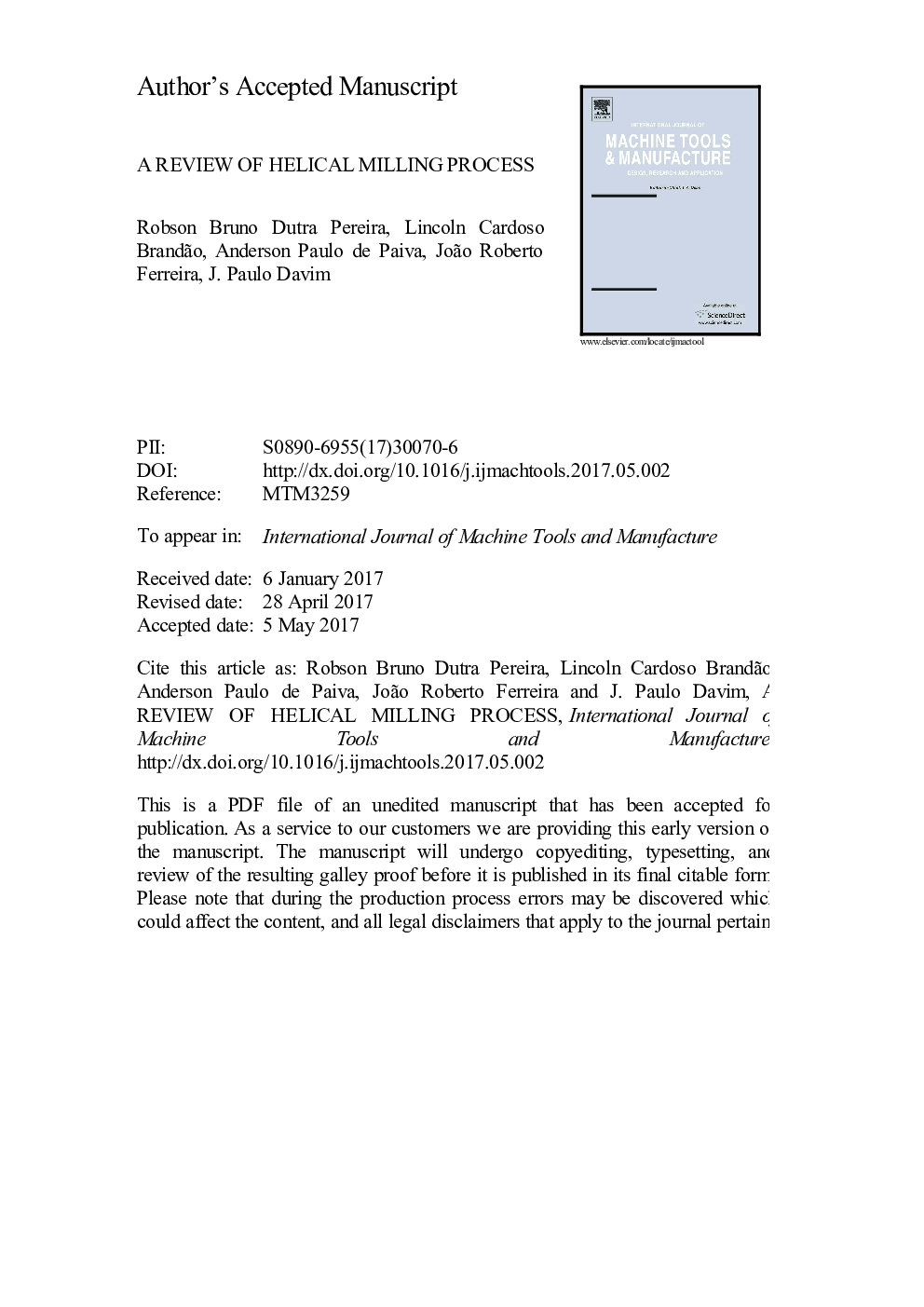| کد مقاله | کد نشریه | سال انتشار | مقاله انگلیسی | نسخه تمام متن |
|---|---|---|---|---|
| 5015725 | 1464474 | 2017 | 42 صفحه PDF | دانلود رایگان |
عنوان انگلیسی مقاله ISI
A review of helical milling process
ترجمه فارسی عنوان
بررسی روند فرآیند آسیابکاری
دانلود مقاله + سفارش ترجمه
دانلود مقاله ISI انگلیسی
رایگان برای ایرانیان
کلمات کلیدی
فرزکاری هلالی، حفاری یاطاقان، حفاری کیفیت چاه،
ترجمه چکیده
فرزکاری حلقه ای یک فرآیند ماشینکاری مجدد سوراخ است که در مقایسه با حفاری های معمولی مزایای متعددی دارد. در فرآیند آسیابکاری، این ابزار مسیری پیچشی را طی می کند و در محور خود چرخش می یابد. با توجه به سینماتیک انعطاف پذیر آن، نیروهای برشی پایین، سایش ابزار و بهبود کیفیت گودال ممکن است به دست آید. این مقاله یک بررسی از فرآیند آسیابکاری را ارائه می دهد. به عنوان اولین مقاله که به منظور توصیف وضعیت کنونی فرایند فرزکاری مارپیچی، آثار اخیر در مورد این فرایند خلاصه شده است، به منظور نشان دادن روند آینده در این زمینه است. در ابتدا مزایای استفاده از میلز مارپیچی با توجه به حفاری های معمولی ارائه شد. پس از آن، سینماتیک فرایند برای استاندارد سازی نامناسب ارائه شد و دانش مربوط به حرکات و پارامترهای فرزکاری مارپیچی ارائه شد. تجزیه سریع خوراک در جهت پیشانی و محیطی نشان داده شد. تراشه ناپایدار و حجم برش برش جلو و محیطی توصیف شده و نسبت بین حجم برش حذف شده توسط برش جلو و محیطی نشان داده شده است که تنها به قطر گمانه و ابزار بستگی دارد. همچنین برش نیروها و مطالعات دما خلاصه شده است، که نشان می دهد فرزکاری صیقل یک روند صاف کردن سوراخ است. پس از آن، مطالعات عمر ابزار و سایش در فرزکاری اسپیندل خلاصه شد، نشان می دهد که تکامل سایش ابزار را می توان در لبه برش جلو و محیطی، با لبه برش جلو، در اغلب موارد، تعیین زندگی ابزار. برخی از برنامه های کاربردی رایانه ای آماری و نرم افزاری بر روی دستگاه های فرزکاری نیز ذکر شده است. برای تهیه دستورالعمل های اولیه برای استفاده از میلز مارپیچ، یک نمایش از ادبیات جاری، تجهیزات خلاصه و تکنیک های خنک کننده مورد استفاده قرار گرفت و سطوح شرایط برش میلز مارپیچی مورد استفاده برای مواد مختلف حفاری. کیفیت گمانه هایی که به وسیله چرخش اسپینال به دست می آید، از لحاظ انحرافات ابعاد، هندسی و میکروگمتریکی، علاوه بر سطوح برانگیختگی و خردایش، به منظور اطمینان از اینکه گمانه های به پایان رسید با آسیاب های حلزونی به دست می آیند، مورد بررسی قرار گرفت. در این نتیجه گیری، فرصت های آینده در مورد تحقیق در مورد میلز مارپیچ اشاره شده است. این بررسی کلی از میلز مارپیچی ممکن است به عنوان خلاصه ای از نتایج کنونی حاصل شده در مطالعات تجربی و نظری و همچنین ارائه نیازها و فرصت های پژوهشی آینده باشد.
موضوعات مرتبط
مهندسی و علوم پایه
سایر رشته های مهندسی
مهندسی صنعتی و تولید
چکیده انگلیسی
Helical milling is an alternative hole-making machining process which presents several advantages when compared to conventional drilling. In the helical milling process, the tool proceeds a helical path while rotates around its own axis. Due to its flexible kinematics, low cutting forces, tool wear, and improved borehole quality may be achieved. This paper presents a review of the helical milling process. As a first paper aiming to describe the current state of the art of helical milling process, the recent works about this process were summarized to point out the future trends in this field. Initially, the advantages of the helical milling were presented with regard to conventional drilling. Subsequently, the kinematics of the process was presented to standardize the nomenclature and to provide knowledge about the movements and parameters of helical milling. It was demonstrated the feed velocity decomposition in frontal and peripheral directions. Undeformed chip and cutting volumes of frontal and peripheral cut were described, and the ratio between the cutting volumes removed by frontal and peripheral cut was demonstrated to be dependent only of the borehole and tool diameters. Cutting forces and temperature studies were also summarized, corroborating that the helical milling is a smooth hole-making process. Afterward, tool life and wear studies in helical milling were summarized, testifying that the tool wear evolution can be monitored in frontal and peripheral cutting edges, with frontal cutting edges, in most cases, defining the tool life. Some statistical and soft computing applications on helical milling were also mentioned. To provide initial guidelines for applying helical milling, a screening of the current literature was performed summarizing equipment and cooling techniques used, and the levels of cutting conditions of helical milling applied for hole-making different materials. The quality of boreholes obtained by helical milling was assessed in terms of dimensional, geometrical, and microgeometrical deviations, besides burr and delamination levels, assuring that it can be obtained finished boreholes with helical milling. In the conclusions, future possibilities on research about helical milling were pointed out. This general review of helical milling may be referenced as a summary of the current results obtained in experimental and theoretical studies and to provide future research needs and opportunities.
ناشر
Database: Elsevier - ScienceDirect (ساینس دایرکت)
Journal: International Journal of Machine Tools and Manufacture - Volume 120, September 2017, Pages 27-48
Journal: International Journal of Machine Tools and Manufacture - Volume 120, September 2017, Pages 27-48
نویسندگان
Robson Bruno Dutra Pereira, Lincoln Cardoso Brandão, Anderson Paulo de Paiva, João Roberto Ferreira, J. Paulo Davim,
